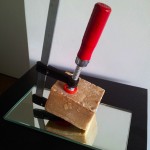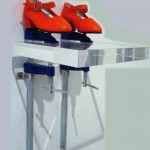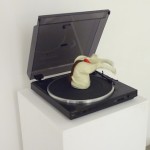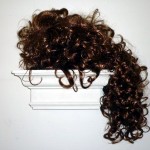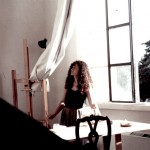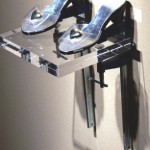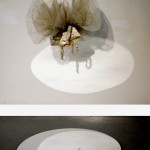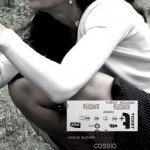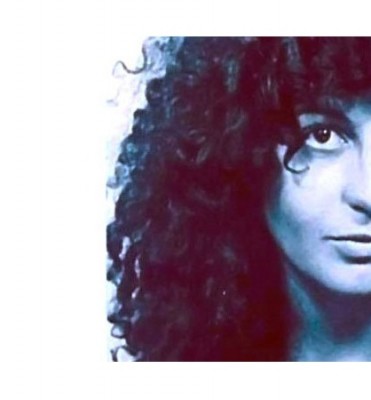In the work of Pilar Cossío, the notion we have of what is obvious and plausible becomes some-thing really much more subtle and complex. Understanding her work requires a period of quiet con-templation, enabling us to mentally lift each of the layers with which she articulates her works in order to formúlate a series of questions that are not only connected to the field of art, but also concern the ephemeral nature of existence itself. This process involves a series of reflections and thoughts that cons-titute a diary of our memory, a record that, far from being merely autobiographical, also constitutes a journey through the world of our experience. We are referring here to an atlas similar to the one emplo-yed by Gerhard Richter, that has provided the foundation for a significant part of his work in recent decades. However, between these two artists we not only find an identical awareness of what has taken place, but their atlases both reflect their recurring obsessions, their passions, their most intímate and also their most confessable thoughts. The current work of Pilar Cossío is, ¡n this respect, the conse-quence of a laborious and essential journey that the artist began years ago and to which she has remai-ned truly faithful. The places she has experienced are transformed into a new unexplored territory ¡n which we find, ¡n addition to these spaces depicted in the form of fire-engraved images, icons of the memory, dream-like memories, an accumulation of new thoughts that crowd together ¡n the form of pieces of paper, colours, drawings and other manifestations of feeling.
In the paintings she presented at her early exhibitions, based on a clearly surreal inspiration, she developed a Neo-Expressionist approach similar to that of her contemporaries and ¡n tune with the new spirit that was to domínate the international art scene during the nineteen-eighties. In these works we were able to observe a type of figuration that vaguely recalled the Germán Jungen Wilden. However, her early stays in Italy coincided with the full development of the Trans-Avantgarde at an international level. The lively forms and the bestiaries that populated these early works, made reference to a much more ancient perspective rooted ¡n the cave paintings of Altamira themselves, although her palette of colours was obviously entirely Italian. What is more, an essential part of Pilar Cossío’s poetic approach is the happy result of her interpretation of the Classical tradition combined with approaches that have much to do with the Italian avant-garde. In her work she managed to combine Nordic energy and pa-ssion with the history and mythical heritage of the Mediterranean. This fusión has generated an abso-lutely personal work ¡n which traces of the past constitute the source of knowledge and memory.
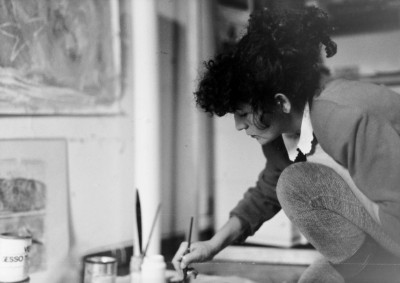
In the late eighties she moved to London on a grant from the Delfina Studio Trust Foundation (where, throughout the institution’s fourteen-year history, artists of the importance of llya Kabakov, Tacita Dean, Anya Gallaccio and Rivane Neuenschwander have received grants). Her paintings became more airy, ethereal and atmospheric, featuring compositions based on an essentially urban theme -har-bour, maritime, industrial and railway subject matters- that recalls futurism and even the metaphysics of De Chineo, sometimes ¡n the formal of a round moulding, profoundly solitary and strangely void of all human presence. These landscapes began to altérnate ín the nineties with her singular collages and photomontages, made up of cut-outs and fragments of architectural and monumental representations, travel tickets, boats and trains, stations, plans and maps, statues, shells, musicians and instruments, deer…, constituting a personal and autobiographical gallery of images created through a series of accidental combinations. This unusual and surrealist mixture of iconographic motifs might also be associa-ted with the Arcadian Retreats and Combine Paintings of Robert Rauschenberg, except for the diffe-rence in the way she handles her material. The title of her exhibition, «Pianura», contrasts radically with the voluptuousness of Rauschenberg’s works. If Pilar Cossío shares a sense of passion with Richter in the sense that art and life both work in the same direction, with Rauschenberg she shares that spatial perspective in which everything comes together, that amalgamation of circumstances and experiences that give rise lo new places when feelings coincide with the territories desired. Paradoxically, Rauschenberg.
ís the pop artist who has interested Richter the most. A perhaps unconscious circle of complicitles has been established between the three artists that places the work of Pilar Cossío among the most established and suggestive of contemporary painting today.
The kind of post-modern collage she has been producing in recent years presents a combination of colours, forms and materials that inter-relate without providing any sense of continuity. There are no spatial or temporal limits. The forms do not fit into the physical limits imposed by the compositional área. They always go beyond it, demonstrating their desire to break past the obligatorily two-dimensiolnal borders of the support. This creates a formidable sense of movement that is enhanced by the use of various types of figuration that highlight this dynamic effect -such as rhínoceroses and shoes- and the expansive nature of the artist’s creations.
The fragments and sections she manipulates possess a stratified presence, being laid one on top of the other, now transparent now opaque; even the fields of painted colour are introduced in the form of another cut-out -Moholy-Nagy would define her creations as photoplastic works-. Her spatial conception sometimes attains considerable levéls of difficulty. She plays around with perspective and representational ambiguities. In «Turín, Turín», the Molle Antonelliana is reflected on a lady’s back whilst her skirt looks like a window, offering an aerial view of the city. Another example of profound elegance can be observed in «Nevermore», in which we can see a rural landscape that brings us back to the magic of ingenuousness through two twin children’s faces that occupy practically the entire composition. In this way the artist creates a sense of interpenetration that creates a profound spatial density.
The idea of travel is another constant feature in her work, in the same way as her inner world and cognitive approaches. The fragments serve to record her experiences during her vital itinerary around various important European cities (Barcelona, Madrid, Florence, Naples, Rome, London, Turin, Paris …). This exhibition is presented as the timeless trace or sediment of her own life, star-ting with her early life in the coastal city of Santander, and continuing with her prolonged Classical and Modern apprenticeship in Italy, her fascination for the dock-lands área of London and her most recent stay in Paris.
The idea of the transitory or of the fleeting implied by the idea of travel is materialized in her creations by the way she embodies a sense of movement. Nothing is stable in her work; What is more, the cut-outs she uses to produce her collages and photomontages, applying them as if they were pigments, are used agaín and again, fulfilling the material role traditionally played by oils in painting, and incorporating a non-chronological element into her poetics. The list of examples is quite endless: the face of the girl we see in «Nevermore» and «Plaine» appeared in «Coal-Bunker» (River Side, Gallería Paolo Tonin, Turin, 1997) and, more recently, in «Autour des choses» (Co/n d’Air, Galerie Weiler, Paris, 2002); the figures in the installation «Orchidée» (Co/n d’Air, 2002) can now be found photographed over a mirror and painted on plástic in «Punto vacío»; ¡n «Ville» we can see the same bare feet we saw in «Port d’étoiles» (Suite, Sala Mauro Muriedas, Torrelavega, 2000), along with the volcano of Naples found in «La vie intérieure» (Jouissance, Spazio Replay, Monaco, 1998); the Molle Antonelliana, that turned into a bullfighter’s head in «Desde un punto vacío» (a E.T.)» (River Side, 1977) is now reflected on the bare back of the woman in «Turín, Turín»; and so on. This recycling of images is very often carried out by varying the transparent layers she superimposes, allowing us to partially see what lies underneath, and then including new graphic images and profiles.
Pilar Cossío’s iconography is equally rhetorical and recurrent, but essentially symbolic. Her predilection for the Classical world is invariably maintained throughout a large part of her work, as witnessec by the reiterated presence of architecture. This insistence on the city theme has much to do with her migratory life, with the idea of transit. The exhibition opens up like an álbum of travel photographs, presenting to us the towers that flank Battersea Power Station in London, various clearly recognizable sections of the Eiffel Tower in Paris and the Molle Antonelliana in Turin, not to mention the profile of Vesuvius in Naples and an image of the Ponte Pietra in Verona.
A more surprising inclusion in her repertoire are her rinhoceros (del sentire), althought these constitute a recurring theme throughout the history of art. Rousseau presented them in a fresh and leafy jungle, whilst Dalí made them the focal point of his trigonometric investigations in works such as «La Madonna del Port Lligat», «Figura rinoceróntica del llisos de Fidias» and «Retrato de Gala con síntomas rinocerónticos» in the 1950’s; and several centuries earlier, in 1515 to be exact, Dürer produced a beautiful wood engraving featuring a monumental rhinoceros that he imagined based on a description. This type of image, dating right back to prehistoric times, appeared in the Paleolithic cave paintings of France and Cantabria and North África. By adopting these motifs. Pilar Cossío seems to draw inspiration from the depictions in the coloured paintings on the ceiling of the Cave of Altamira. There are some similarities, in this résped, between her execution and that of the cave paintings, namely, the use of superimposition and outlines of continuous and highly synthetic lines. These rhinoceros profiles, rather than embodying a personal symbolism, bear witness to her passion for drawing, to the sinuous nature of her graphic style and the opportunity they offer her to créate a greater dynamic sense. Furthermore, she does not only employ drawing techniques in this kind of depiction, but often combines them with other iconographic motifs, especially in works such as «Clair de lune», «Ville» and «Git-le-coeur».
High-heeled shoes represent valúes and roles typical of women and are presented as quintessen-tial symbols of female seduction. In the same way as her rhinoceroses, these shoes present a curved silhouette that is frequently repeated. In the form of a ready-made rebore, ¡n the installation entitled «Naissance» she presents a pair of women’s shoes that are attached to the wall by means of DIY gripping devices. In «Les années Toscanes», the toes of a pair of shoes point towards a superimposed sky alongside a mill and a kind of lighthouse, whilst in another work produced with mixed technique, «Huitiéme», the soles of the two shoes, also placed in vertical position, present a mysterious reflective effect. In «Eurídice», a title that makes reference to her interest in music, a multitude of large high-hee-led shoes walk over a city. The idea of transit, circulation and fleeting moments returns; but we also find the idea of invasión, occupation. These ideas also seem to be suggested in «L’Oublie», where a pair of women’s legs intertwine with the image of two Germán planes from the Second World War. In «Punto vacio» we can see an army advancing whilst the image is duplicated in a mirror, a direct reference to the most recent international conflicts. However, these high heels are especially synonymous with the idea of femininity and therefore refer to all the situations and circumstances that women today find themsel-ves in: ranging from their advertising or rhetorical image to aspects relating to violence, maternity and sexuality. Other artists, such as Dalí himself and the rest of the Surrealísts, or more recently Juan Muñoz and Victoria Civera, have also used this same iconography to depict or reflect upon the same matters and themes, which once again places Pilar Cossío within the context of a sensibility shared with the most advanced contemporary trends.
Irrespective of other semantic considerations that may be appropriate, the iconographic cut-outs and fragments with which Pilar Cossío articúlates her compositions seem to be more or less conclusive stages in a larger work that is still under construction. Pilar’s journey is one of comings and goings, of subtle associations, of infinite search, of an incessant flow that enables temporal and spatial conventions to build up and allow and new lessons, known as memory, to flourish in new creations.
FERNANDO FRANCÉS 2003/2004

